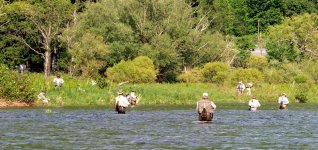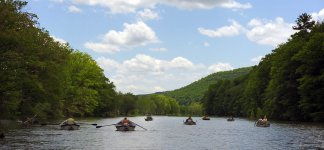Lehigh Ed,
Here are more details in a news release. Actual numbers and graphs are included in the link below. It looks like a step in the right direction.
NEWS RELEASE
FOR IMMEDIATE RELEASE
CONTACT: Gary Paulachok, Deputy Delaware River Master, (570) 296-7213
DECREE PARTIES ANNOUNCE CHANGES TO THE FLEXIBLE FLOW MANAGEMENT PROGRAM
TO IMPROVE HABITAT PROTECTION IN SUMMER 2009
MILFORD, Pa. (June 1) – In a continuing effort to improve the habitat
downstream of the New York City (NYC)-Delaware Basin reservoirs, New
York State, Pennsylvania, New Jersey, Delaware, and the City of New York
(Decree Parties) today announced two agreements to revise reservoir
operations based upon the December 10, 2008 Flexible Flow Management
Program (FFMP).
The first agreement, in effect through May 2010 only, is designed to
provide additional habitat for trout in the West Branch of the Delaware
River by increasing cold water releases from NYC’s Cannonsville
Reservoir during the summer 2009 period from June 1 through August 31.
The additional cold water will also benefit the Upper Delaware River
main stem. Cold water released from the bottom of the reservoir will
help the renowned trout fishery by reducing thermal stress caused by the
summer’s warmer temperatures. Absent prolonged drought conditions, the
agreement increases the base Cannonsville release by up to 25 percent to
325 cubic feet per second for most of the summer. It also reserves a
quantity of water in an “Extraordinary Needs Bank” to be available to be
used by the Decree Parties for unforeseen needs. The agreement resulted
from the recommendations of state fishery experts and a review of the
2008 operations of the FFMP.
The second agreement will serve to reduce storage zone bouncing, an
effect that results in rapid increases and decreases in the reservoir
discharge mitigation release rates, (known as the yo-yo effect) by
allowing NYC operational flexibilities to better manage release rate
transitions during rapidly fluctuating reservoir storage levels. During
certain periods of the year, the reservoir levels are more subject to
increases and decreases around the trigger points that can result in
excessive bouncing between storage zones and release rates. In the
spring and fall, changes in releases are more substantial and rapid
fluctuations are generally something that fishery experts would prefer
to avoid as they can be detrimental to river habitat. This is an
amendment to the FFMP which provides NYC with the flexibility, in
cooperation with the New York State Department of Environmental
Conservation, to modify releases to avoid unreasonable fluctuations in
releases.
Both agreements revise operations in accordance with the FFMP agreement
that governs NYC-Delaware Basin reservoir diversions and releases under
the terms of the 1983 Good Faith Agreement The FFMP, which was
originally adopted in September 2007 and amended in December 2008, is an
adaptive and collaborative approach by the five Decree Parties. An
advantage of the FFMP is the ability of the Decree Parties to make
adjustments as either new information is presented or as scientific
understanding improves or meteorological or environmental conditions
warrant.
These two changes announced today are another demonstration of the
adaptable approach embodied in the FFMP concept. Among other things, the
FFMP is designed to provide safe and reliable supplies of water
essential to serve the needs of the 15 million people who get their
water supply from the Delaware River Basin, which also supports a
diverse wildlife habitat. These amendments to the FFMP will enhance the
balance needed to protect this vibrant recreational fishing resource
during the warm summer months, while still protecting the water supply
so vital to the public and our economy.
The FFMP and its associated agreements may be accessed at the U.S.
Geological Survey Office of the Delaware River Master web site.
Temp D Flow Plan




